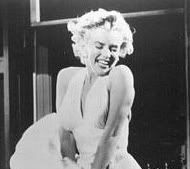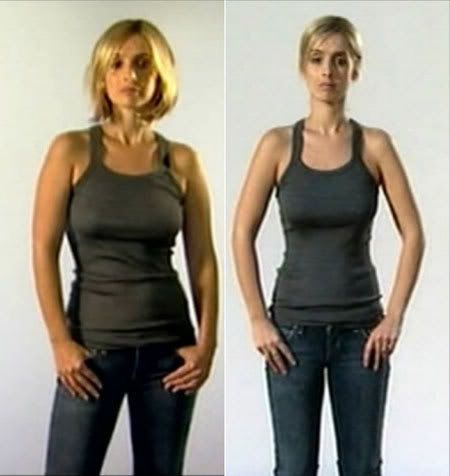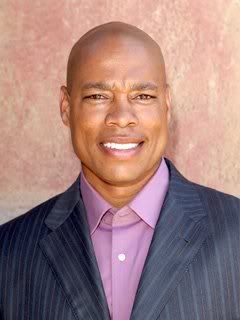So, bearing in mind that body-image is a hall of mirrors within a forest of uncertainties, I took a call from a friend of mine with some trepidation. He has a daughter who has a fascination with serial dieting punctuated with overeating that, he fears, is teetering along the edge of becoming an obsession. He doesn't have a computer, so asked Maxima and me to have a look at a documentary about a starlet who goes on an extended eating binge to see what the effects on her body might be.
Claire Sweeney starred in the British soap opera Brookside and later in Celebrity Big Brother (pre-racism), after which she got roles in acting, presenting, and in musicals. The documentary I was contacted about was aired on ITV on Tuesday, 7 January, and was called Claire Sweeney's Big Fat Diet.
Sweeney, who was briefly bulimic after a crash diet as a teenage dancing student, spent six weeks eating what she wanted while also ceasing her punishing exercise regime. During the six-week period she woould go into restaurants and look at the menu, something she would never have done beforehand in order "to avoid temptation".
Coming from Scotland I'm an expert in chips, which Sweeney ate in spades, using more tomato ketchup than even a Scot could shake a stick at, drank more alcohol, and at one point complained that she couldn't see her feet. I know an easy way to see your feet: sit down and stick your legs out.
A doctor who monitored her health at some points through the experiment remarked that at the end of the six weeks her blood-pressure had rocketed up, which would put her at an increased risk of heart-attack and stroke should it remain high for a prolonged period. This obviously sounds concerning, but, despite the programme's good intentions, it seemed to be far more about appearance than health.
For example, Sweeney went to Los Angeles, "a city where thin is in". She visited a plastic surgeon's office, who possible said more than she meant to when she admitted that "here in California we [in the film industry] like a little more boyish bodies...it's a commentary on society".
I don't blame the surgeon for this, nor do I totally blame the film industry, although the latter certainly plays its part in deconstructing traditional Western values and society. I blame the international fashion industry, whose svengalis, for their own questionable reasons, like to take girls in their late teens and make them look barely-pubescent - which erupted in the recent heroin-chic controversy; fitness trainer David Kirsch has remarked that he's met models who are "struggling with a serious eating disorder". Indeed, Sweeney visited former Hollywood casting director Pamela Shae, from whom she discovered that not only that her new curvy body would qualify her for a "comedy" role, but also that were she to take on a role in a series looking thin but then gain weight, she would be reprimanded.
In the end, we are informed that Sweeney went back to her training regime and lost the wei
 ght, but at least she gained two pieces of wisdom: firstly, that the urge to slim down is more due to peer-pressure than to any desire to become attractive in any sense, and secondly - a stunning insight into the male psyche - "men seem to like curves". She's not wrong - a dress of the most famous female sex symbol ever, Marylin Monroe, was auctioned and found to be a size 16.
ght, but at least she gained two pieces of wisdom: firstly, that the urge to slim down is more due to peer-pressure than to any desire to become attractive in any sense, and secondly - a stunning insight into the male psyche - "men seem to like curves". She's not wrong - a dress of the most famous female sex symbol ever, Marylin Monroe, was auctioned and found to be a size 16.So I won't be recommending this documentary to my friend, because Sweeney's obsession with her appearance, as opposed to her health, appears liable to trigger girls (and boys) who may be on the verge of developing an eating disorder.
O
 f much more merit, I thought, was a documentary made somewhat earlier by British singing star and presenter Louise Redknapp (née Nurding), in which she endeavoured to diet until she reached size zero (which I believe is UK size 4). During the course of this she became depressed and lachrymose, and seemed herself to border on developing an eating disorder as the control she experienced over her body became more valuable than just about any other consideration. Catwalk Queen comments:
f much more merit, I thought, was a documentary made somewhat earlier by British singing star and presenter Louise Redknapp (née Nurding), in which she endeavoured to diet until she reached size zero (which I believe is UK size 4). During the course of this she became depressed and lachrymose, and seemed herself to border on developing an eating disorder as the control she experienced over her body became more valuable than just about any other consideration. Catwalk Queen comments:It really is impossible to get the message through to the fashion industry that size zero is NOT attractive. Stella McCartney and John Lewis might be trying to change things by using larger models, but we have a long road ahead of us. Though I can't imagine fashionistas taking advice from a woman who used to be in a girl band, hopefully Louise's documentary will make impressionable young girls think twice about crash-dieting to get down to skeletal proportions. Is being super-skinny really worth losing the light in your eyes and alienating your loved ones?While Redknapp's documentary was a valuable piece of research on dieting and its results with close medical control throughout - and included visiting a unit for girls with anorexia, the youngest of whom was twelve - Sweeney's was an opportunistic piece of awareness-raising about Sweeney, which was funded by Weightwatchers. I don't wish to take this outfit to task too robustly, as I believe it has a responsible attitude to prospective clients with body-image problems and donates to the British Heart Foundation, but I am worried about a documentary, to which girls with body-image issues will be attracted like barnacles to the hull of a ship, being effectively sponsored by an organisation which exists to help people lose weight in return for money.
Besides the documentary, Sweeney has just made a fitness DVD with Weightwatchers, featuring
 her personal trainer, Caroline Sandry, who also appears in Sweeney's documentary. Do I detect a covert selling campaign dressed up as concern for people's health?
her personal trainer, Caroline Sandry, who also appears in Sweeney's documentary. Do I detect a covert selling campaign dressed up as concern for people's health?There is, fortunately, some good sense out there. While Sweeney's plastic surgeon said that cosmetic procedures were not so much drastic actions as routine maintenance, former US Marines Drill Instructor and fitness instructor Harvey Walden calls it "lazy and invasive". One of my favourite politicians, Anne Widdecombe, investigated diets and expressed concerns over "who it is that decides what this perfect image is".
As the Greeks said, everything in moderation; and in the world of food, that includes moderation.
Related posts:
Abigail Blackburn and the truth about pregorexia
Body image isn't all it looks like











Well, I don't believe there is any such thing as altruism, outside of Christianity, and even within it, it's pretty rare. So we must go at all these efforts to help, with a sieve in hand. Or a thresher.
ReplyDeleteI never buy women's magazines for the reasons you gave. They seem trashy, for the most part. And even the ones that don't are pretty frivolous. I can see wanting an occasional dose of frivolity, but I remain hesitant to pay money for it, both in the interests of my pocketbook, and in reluctance to support the industry.
Aside from all that, after all the holidays my husband and I could both stand a diet, for health reasons at least. (You can't tell it from the photo - it's almost a year old.)
Finally, yes, I've noticed men don't generally like the ultra-thin look. Only women. I've also noticed that many (most??) men don't really like makeup on women, either. More peer pressure.
I think the photo's great!
ReplyDeleteI think you're right about altruism, unfortunately.
My wife used to be hooked on women's magazines, but then realised, as you say, how trashy they are.
Dieting for health sounds good, but even that can be a quagmire; I remember when I'd just started in nursing, there was a big story about how the US Surgeon General had withdrawn height/weight charts because they were deliberately skewed to give a result showing people with health ratios to be overweight. They were sponsored by companies making "slimming medicines", which I came across several times when I was a drugs worker. I also saw girls training to be dancers who took cocaine in order to lose weight. I suppose as a former health-worker I get quite anxious when meeting women with the ultra-thin look.
I'm probably unhealthily fat, but what's going to be the result of me slimming - eternal life? We bith know a better way to get that.
All I want is to get my children out on their own and not dependent on me. That's about enough of worrying about health.
ReplyDeleteHow much would you say a woman 5 feet 4 inches (are there British measurements for that, too?) of medium build ought to weigh???
Pam, I understand what you mean by 5'4"; when I went to school they were starting to teach metric measurements, but nobody used them. I still think in terms of feet, pounds, etc instead of metres and kilograms.
ReplyDeleteI'm at work, and have been looking up the BNF (British National Formulary), which used to have height/weight charts - but they've stopped printing them, probably because of body image concerns. Also, rugby players (and probably American football players) came out as obese in the charts, because they're big lads, work out a lot, and muscle weighs a lot. I wouldn't like to trust such an important issue to what I might google.
I really wouldn't like to guess what a lady of 5'4" should weigh, because there are so many variables - muscle-to-fat ratio, extent of water-retention, bone structure, etc etc etc. I think we "ought" to weigh what feels best. (Not that I'm trying to get out of the question...) - FD
Of course you are trying to out the question Dougal! haha-- and wise you are.
ReplyDeleteI had an eating disorder in high school... there- I said it. I was a fat child, didn't eat healthy. In high school, low self esteem and thinking I was ugly with the fat lead me to purging. It wasn't about the super models though; I think it was more about self loathing, attention, control, etc.
Now, I want to look healthy. I want to BE healthy.
The magazines? Oh yeah, trashy. But not just because of the ultra slim models, but because of the obsessive consumerism and sex and outright exposure.
BTW, when Marilyn Monroe was alive, the sizes were different. Because of the obsession to be smaller, the industry has actually lowered the sizes on the label during the past 30 yrs. Someone who weighs what they did 30 yrs ago, for instance, would be two sizes smaller because the sizes have changed.
Oh, and you think that photo is great? Thank you! I took it!
ReplyDeleteShe is cute, isn't she?
So...are you saying that when Marylin Monroe's dress was measured and found to be a size 16, it would have been a size 18 in Marylin's day?
ReplyDeleteYep, I do like the photo - well done! They really are a lovely couple and, yes, Pam does look cute!
No, I'm saying that Marilyn would wear [more like] a 10 by today's standards. We FEEL better about ourselves if the number is smaller, so the industry has lowered the numbers. A size '0' didn't even exist 40 years ago, not that some people were not that thin.
ReplyDeleteI know what you mean, I lost my figure after my wife had the children.
ReplyDelete